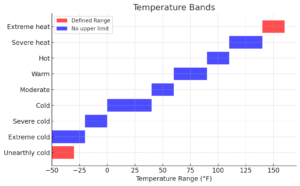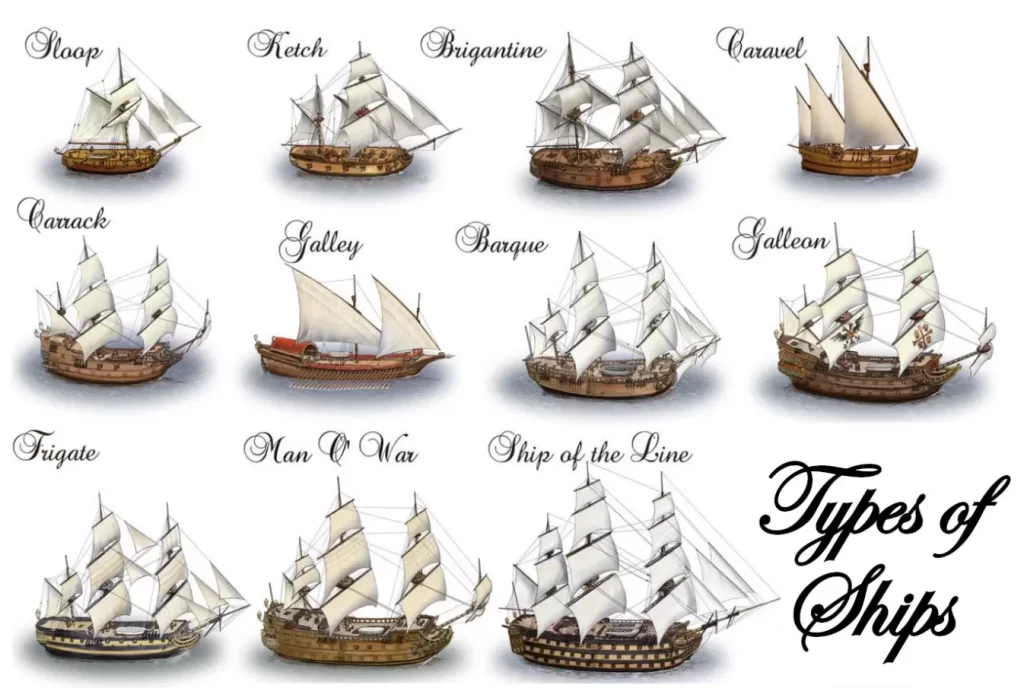
The Captain
The Captain of all ships is the study in leadership and paradox. When our minds dance with the imagery of captains, we often conjure images of stern-faced, unyielding individuals, blackhearted slave drivers who might well be likened to some battle-hardened managers in the customer service industry. But peel back the layers of fiction and myth, and a more nuanced picture emerges. You see, there are two very distinct breeds of captains etched into the pages of history: Pirate Captains and Legitimate Captains.
Pirate captains, those fearless leaders of lawless seas, were elected by their merits in battle and undying dedication to the crew. They were comrades-in-arms, considered equal to the crew, their authority resonating only during the frenzy of raids and battles. On the other side of the coin, captains serving in the Navy or aboard any legal-bound ship were chosen through the ladders of rank and wealth. Their worlds were marked by a palpable divide between the captain and the crew, a divide unseen on pirate ships. To encapsulate this dichotomy, one might say that legal ships were arenas of Capitalism, while pirate ships were unflaggingly Democratic.
The Crew
First Mate: The Captain's Right Hand
The First Mate, the captain's deputy, stands as a figure of dependability. In the absence of the captain, they don the mantle of leadership, mainly a trait found on Navies and merchant ships. Pirates, with their unique hierarchy, usually placed their quartermaster in this esteemed deputy role.
Quartermaster: The Ship's Beating Heart
Much like the ship's HR manager, the Quartermaster is entrusted with the essential task of ensuring the ship's smooth operation. They oversee supplies, wield powers to punish the crew for minor transgressions, and ensure the intricate web of duties and relationships remains taut and harmonious.
Sailing Master: The Navigator's Art
These officers, holding the compass of the ship's destiny, were responsible for piloting. They were scholars of the sea, whose education enabled them to read maps, a role that was both desired and respected. Pirates, ever pragmatic, would often abduct sailing masters from conquered ships for their expertise.
Gunner: Master of Firepower
Gunners, the overseers of those qualified to unleash fire and thunder, aimed cannons and maintained the crew's safe handling of guns. These specialists were aided by young boys known as powder monkeys, tasked with loading the guns.
Boatswain: The Watchful Eye
Boatswains or junior officers acted as vigilant supervisors, eyes trained on the crew's performance. Should things fall short of expectations, they would report to higher authorities, such as the captain or quartermaster, to mete out punishment.
Surgeons: Healers and Harvesters
Surgeons at sea were the guardians of life and limb. With resources limited, they often had to resort to drastic measures, such as amputations, to stave off diseases like gangrene. On some ships, the lines blurred, and cooks or carpenters found themselves pressed into surgical service. To them, as the grim saying went, meat was meat, and cutting was cutting.
Cooks: Sustainers of Life
Finally, the humble cook, an essential part of any ship's crew. Navies and merchant ships often boasted trained culinary artists, while pirate ships usually depended on a crewmember gifted with culinary flair. Every ship, no matter its mission or creed, needed someone to nourish the body, just as its leaders were tasked with nourishing the soul.
In this exploration of roles and ranks, we discover a fascinating thread of the crew woven of duty, honor, pragmatism, and the complexities of human nature, a reflection of the diverse and often contradictory aspects of life at sea.
Ship Anatomy
- Aft/Stern - The back of a ship.
- Bow - The bow is the front part of the ship, the pointy part or the place where Kate Winslet stood on in Titanic.
- Port - The left side of the ship
- Starboard - The right side of the ship
- Windward - The wind the direction is blowing.
- Hull- outside of the ship
- Leeward - Or sometimes called the lee. This is the opposite direction of the wind is blowing
- Boom - A horizontal pole extending from the base of the main mast. It adjusted toward the wind direction in order to harness the wind for the sails.
- Rudder - The rudder is a flat piece of wood below the ship, used to steer the ship. It is connected to the wheel of the ship.
- Tacking - A common sailing maneuver that involves turning the bow through the wind, to change the wind direction from one side of the ship to the other, making the boom move.
- Underway- This is when the ship is moving
- Astern- The ship is moving backwards
- Amidships- Middle of the boat
- Topside- when you move from the lower decks to the upper deck
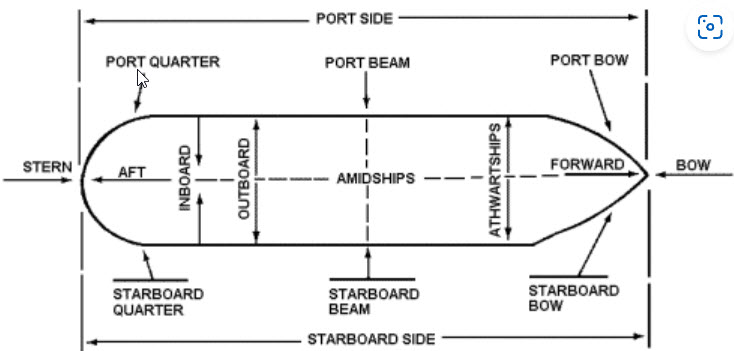
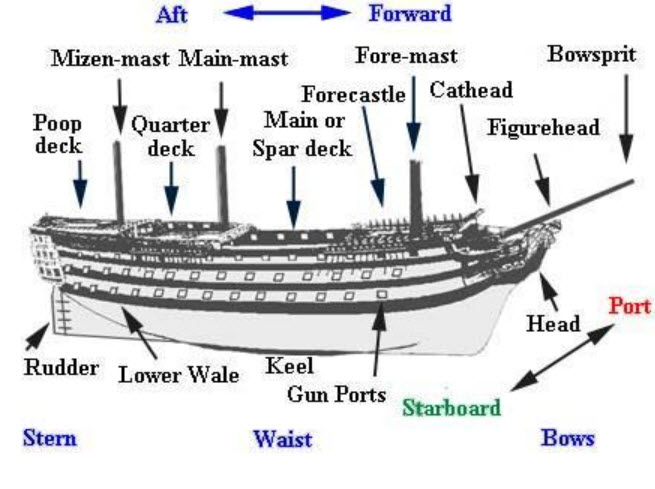
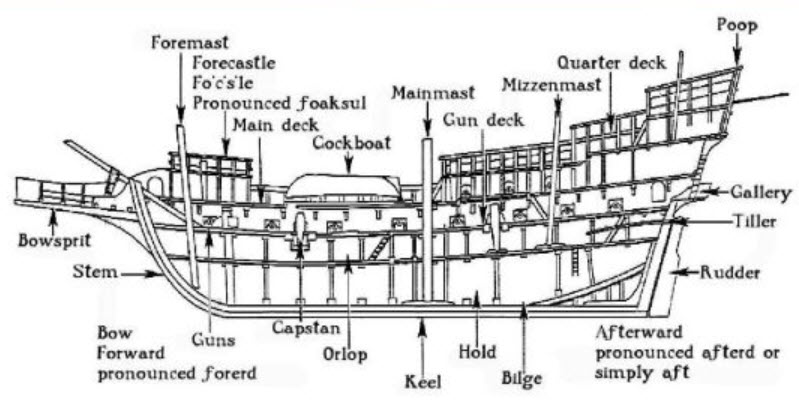
Ship Compartments
Most ships would have compartments inside the hull and underneath the deck.
- Cabins- most war ships and merchant ships would only have one or two main cabin occupied by the captain and higher crew.
- Galley- The kitchen on board the ship. The galley would be fitted with tables and cabinets. Galleys were built in such a way that they were more resistant to the heaving of the ship. Most galleys were built with special stoves to stop people from colliding with them and things from spilling out of pots and pans.
- Wardroom- some ships are built with a common room for the crew. The wardroom acted as a common room as well as a dining room. It would usually be conjoined with the galley.
- Sick Bay- is the compartment of the ship that is given over to the injured and sick. The sick bay would hold the medicines and medical devices and would often be under lock and key.
- Hold- This will be the largest compartment in the ship were the cargo or the ship's weapons.
Read about Table of Ships




